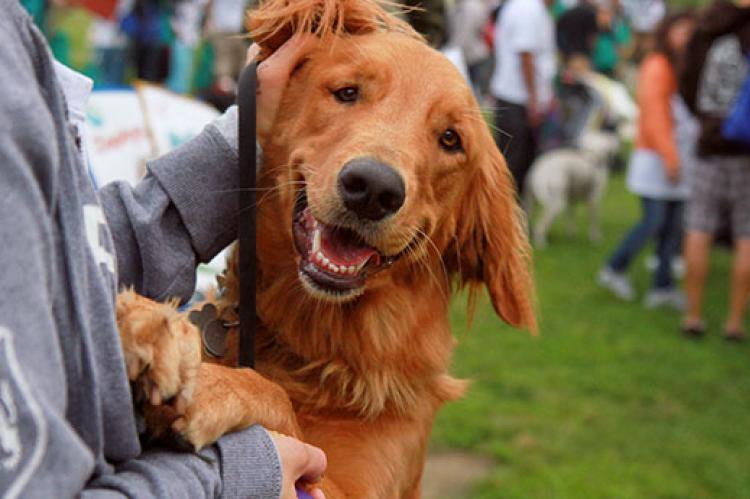How to Stop Dogs From Jumping on People

Dogs jumping on people as a greeting can be unpleasant or even dangerous. Even small dogs jumping can startle someone or cause them to lose their balance. And while excited puppies jumping on people may seem cute, it’s not a behavior to encourage as it can become more problematic as they get older and bigger. Fortunately, the dog training method to stop dogs from jumping up on people is simple, as long as you are consistent with it.
What does it mean when a dog jumps on people?
A dog who jumps on people most likely does it because they get attention for it. Even pushing the dog away or shouting at them can seem like part of the game to the dog. It is attention, after all.
Of course, some people actually enjoy and encourage the jumping by laughing and playing with the dog when they do it. It’s important to ask these people not to encourage the dog to jump up, as hard as it might be for them. Everyone has to play a part in teaching the dog good manners.
How to get a dog to stop jumping on people
The best way to teach a dog to stop jumping up on people is to teach and practice proper greetings. Dogs can easily learn to sit every time they greet a person, even when they are very happy to see that person. When they are trained to associate meeting a person with a sit cue and a treat, soon they will sit and wait for a treat without a cue.
Here are the dog training steps to follow:
- First, prevent the dog from practicing the jumping behavior, so they don't get a chance to receive any kind of attention for it. Whenever you have guests coming to your home, keep the dog in a separate room, behind a gate, or in an exercise pen when the guests enter.
- Next, teach your dog the sit cue. Hold a treat in front of the dog’s nose, just out of the dog’s reach. Raise the treat toward the top of the dog’s head. When their head follows the treat up, their rear end will go down. When the dog’s rear hits the floor, use a marker (click a clicker or say a word like “yes”), give the dog the treat, and praise them. If the dog jumps up rather than sits, you are holding the treat too high. If the dog backs up, try teaching the cue with a wall behind the dog.
- When your dog is consistently sitting for a treat, start practicing with yourself as the visitor. Place a mat or dog bed inside the entryway of your house on the spot where the dog will be situated when the door opens. (Because many entryways are tile or wood, a dog will be more willing to sit or lie on something more comfortable and less slippery.) Place a treat jar outside your door.
- Go outside, pick up a treat, and as you enter the house ask the dog to sit. Use your body to position the dog on the mat as you walk in. Do not give the treat or praise until the dog sits. Be patient and avoid using an angry tone if your dog doesn’t do what you want. Just say “sit” once and wait. If necessary, lure the dog into a sit with the treat. If your dog doesn’t sit, practice some more without exiting and entering, and use more enticing treats. When the dog is consistently sitting for a treat, try the exit-and-entry routine again.
- When your dog is greeting you with a good sit as you open the door, you can start adding a knock or ring of the doorbell. When the dog is doing well with that, practice with friends. Have friends come to the door, knock, and ask for a sit as they enter. Leave the treat jar outside the door so that everyone who enters can be prepared to reward your dog for a polite greeting.
Maintaining good dog greetings
While your dog is learning, it’s important to reward them with food for polite greetings every time. After lots of practice and success, you can start using only praise sometimes, but continue to use food frequently enough to maintain the polite greetings.
Your dog might be so excited or habituated to jumping up on people that learning to automatically sit might be tough. If they jump on you, turn to the side and stop giving them attention. Once they stop, ask for a sit and then reward with a treat. Refrain from giving lots of praise and getting them excited, as this might cause them to jump up again. If they continue to jump, you can remove yourself from the room or area.
In addition, when you start practicing with new people, use a gate or exercise pen as necessary to prevent the jumping behavior. Reward the dog for sitting behind the barrier. After the dog is sitting consistently, you can stop using the barrier. But if your dog ever shows any lapses in politeness, back up in your training.
The last step is to take it on the road, getting your dog to greet other people politely when leashed and on walks, when visiting other people’s homes, and otherwise out in the world. If someone wants to meet your dog, ask the person not to approach unless the dog is in a sit. If necessary, lure your dog into a sit with a treat.
Finally, remember to reward the sit with a treat every time while the dog is learning. You want to make it as easy as possible for your dog to succeed.